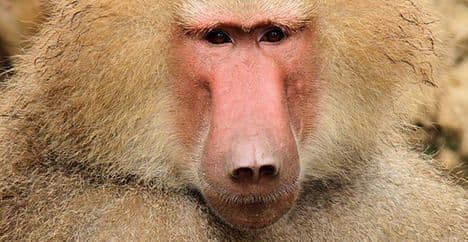Baboons 'recognize written words'

Baboons can recognize scores of written words, a feat that raises intriguing questions about how we learn to read, scientists reported on Thursday.
In a specially-made facility in France where they could come and go at will, monkeys learned to differentiate between a real word, such as KITE, and a nonsense word such as ZEVS.
The baboons had access to a large enclosure with several touch-sensitive computer screens, each projecting a four-letter word.
The animals had to tap one of two shapes on the screen to show that they understood whether the word was a real one or garble.
Choosing the real word got them a tempting reward of food – a pellet of dry wheat that came from an automatic dispenser.
The six baboons used the computers up to 3,000 times a day, notching up an average total of 50,000 "trials" over a month and a half.
They learned to distinguish scores of words, identifying them with an accuracy of 75 percent, according to the study led by Jonathan Grainger at the Cognitive Research Laboratory at France's Aix-Marseille University.
There were 500 real words and 7,832 nonsense ones in the data bank.
"This ... is a remarkable result, given the level of orthographic similarity between the word and nonword," according to the paper, published by the US journal Science.
"More detailed analysis revealed that baboons were not simply memorizing the word ... but had learned to discriminate words from nonwords on the basis of differences in the frequency of letter combinations."
The champion speller was a baboon called Dan, who learned 308 words, around three times as many as his chums.
There was no sign that the animals actually understood the meaning of the words.
But the fact that they learned to distinguish one word from another opens insights into the acquisition of reading.
According to a popular theory, we humans learn to recognize words thanks to speech – we process the sequence of letters into words by building on the sequence of sounds in speech.
But the baboons do not speak any human language, which means the speech hypothesis "may be at best incomplete and possibly wrong," said Michael Platt and Geoffrey Adams of Duke University in North Carolina in a commentary also carried by Science.
That leaves the field open for a rival theory: that there are brain circuits which evolved to support other functions – and we share this circuitry with our primate cousins.
One possible candidate is the visual word form area (VWFA), in the occipitotemporal sulcus region of the brain.
If so, the evidence of cerebral versatility is reassuring news for people with reading difficulties.
"The observation that the neural circuits involved in reading and writing are not hard-wired may explain why most people with dyslexia can learn to read," said Platt and Adams.
"The very plasticity that enabled humans to invent reading and writing can be harnessed to overcome dysfunctions in the underlying neural circuitry."
Join the conversation in our comments section below. Share your own views and experience and if you have a question or suggestion for our journalists then email us at [email protected].
Please keep comments civil, constructive and on topic – and make sure to read our terms of use before getting involved.
Please log in here to leave a comment.